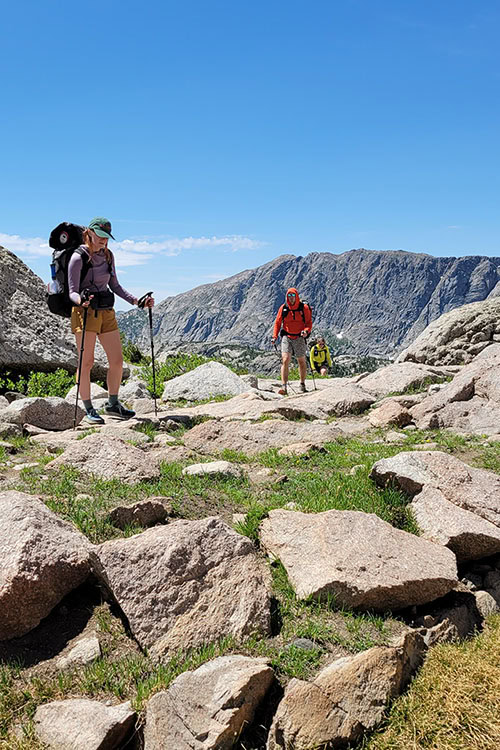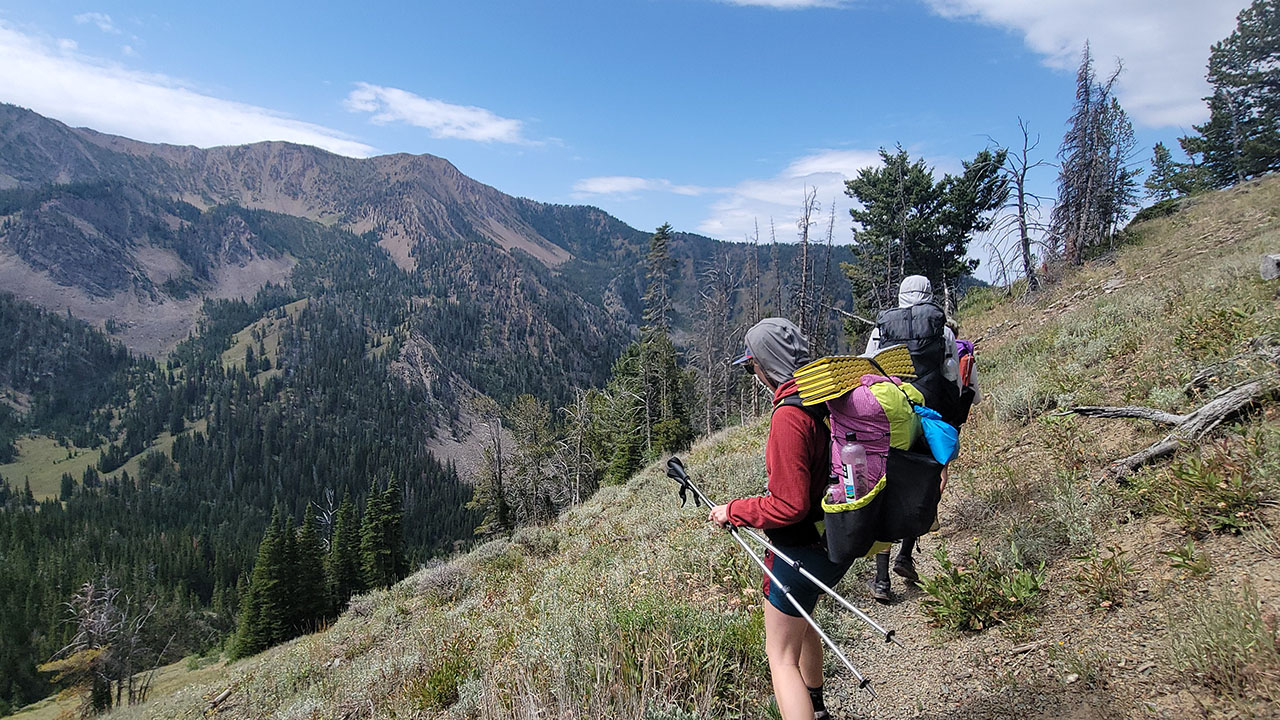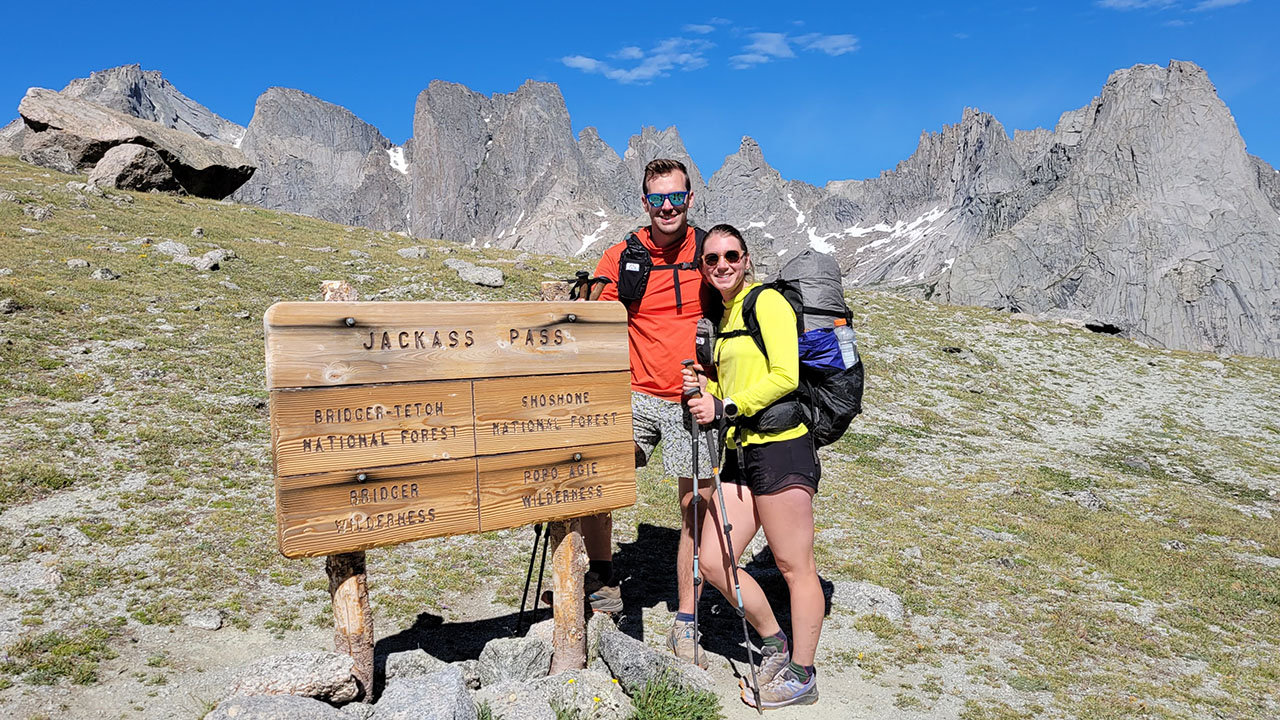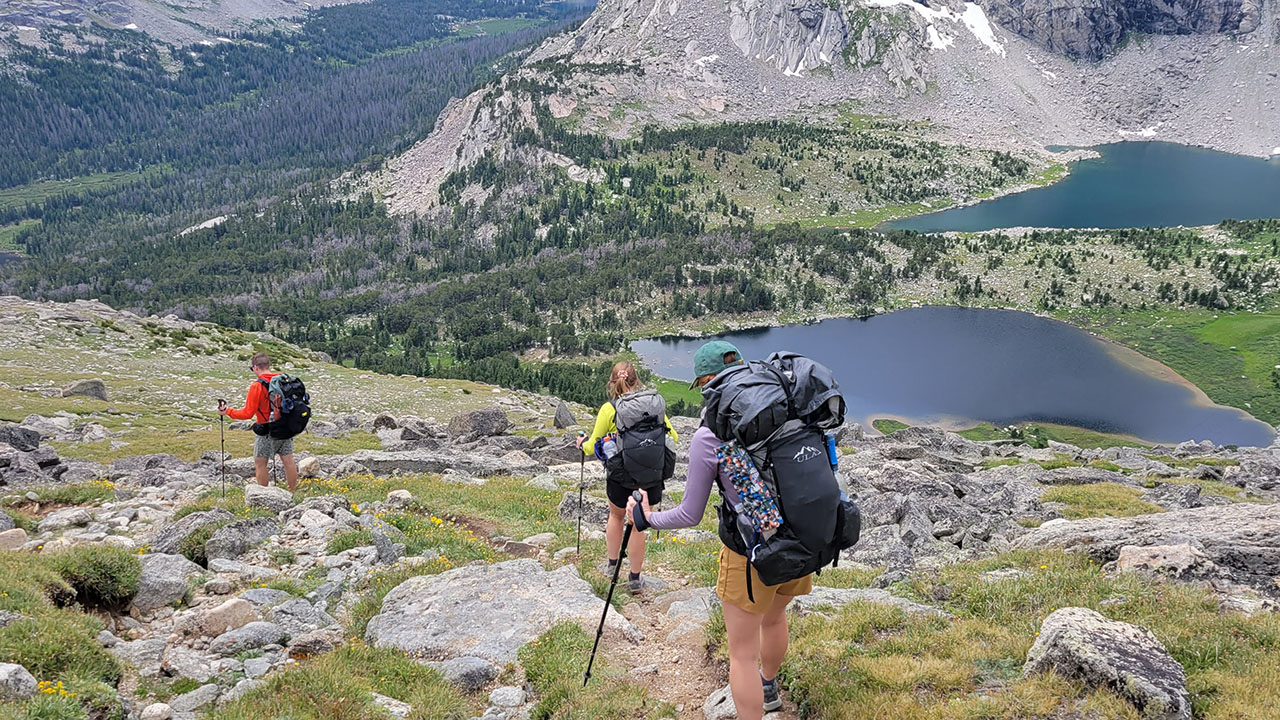
How to Adjust to High Elevation: Symptoms, Risks, and Tips for Altitude
In continued pursuit of supporting those that live in the flat lands, and in case you didn’t read the title, today’s topic is elevation. Last week we posted an article about common trail injuries and how to treat them, and it was brought to our attention that we completely missed talking about one of the most impactful and unavoidable threats on trail – elevation. While out thru-hiking or exploring new wilderness areas in the mountain west, it’s inevitable that you’ll find yourself at heights that can greatly impact your body and thus your time outside. If you live at sea level, spending time in the mountains can take your breath away, and not always in a good way. Even spending time in the mile high city of Denver you might feel the impacts of its elevation, making you nauseous and dizzy, queasy with a loss of appetite, and wondering if it was just the edibles or if something else is amiss.
What Happens at High Elevation
At higher elevations, there’s less oxygen in every breath you take. You’ll generally feel the impacts of elevation above about 6,000 feet, but there are plenty of instances where people experience altitude around even just 5,000 feet. Your breathing rate increases, your heart works harder, and simple tasks can leave you winded. This is your body struggling to adapt to the thinner air.
If you’ve ever felt dizzy, tired, or had a mild headache on your first night in the mountains, that’s your body adjusting to altitude.
Preparing for the Ascent
When people say the air is “thinner” at higher elevations, they mean there’s less oxygen in every breath. The air still contains about 21% oxygen, but as altitude increases, air pressure drops, so the oxygen molecules are more spread out. At sea level, your lungs pull in plenty of oxygen with each breath. But at 10,000 feet, every inhale delivers roughly 30% less oxygen. Your body has to work harder to get the same amount it’s used to, which is why you breathe faster, your heart rate rises, and physical effort feels tougher until your body adapts.
Over time, usually a few days to a couple of weeks, your body starts to acclimate to the thinner air. It does this by producing more red blood cells to carry oxygen, increasing your breathing rate even at rest, and slightly boosting your heart rate to deliver oxygen more efficiently to your muscles and brain. These changes help offset the lower oxygen levels, but they take time to develop. That’s why pacing your ascent and giving your body time to adapt is the single best way to avoid altitude sickness.
While out hiking the Colorado Trail we stayed at a hostel in Leadville and shared the room with a few runners who came into town early before the Leadville 100 to give themselves adequate time to adjust to the altitude before starting the race. One guy had even been there for about 2 weeks!
As you ascend, the air pressure drops, meaning there are fewer oxygen molecules available with each breath. Your body is designed to maintain equilibrium, and it immediately begins a process called acclimatization to cope with this change.
Initially, your body tries to compensate by:
- Breathing faster and deeper: This increases the amount of oxygen you take in with each breath.
- Increasing your heart rate: This pumps blood, and therefore oxygen, to your muscles and organs more rapidly.
After a few days at altitude, your body enters the next phase:
- Increased red blood cell production: Your kidneys produce a hormone called erythropoietin (EPO), which stimulates your bone marrow to create more red blood cells. These cells are responsible for carrying oxygen throughout your body, so more red blood cells mean more efficient oxygen transport.
- Changes in blood chemistry: Your blood becomes more alkaline (less acidic) which helps unload oxygen from hemoglobin to your tissues more easily.
- Increased capillary density: Your body may develop more tiny blood vessels (capillaries) in your muscles, further improving oxygen delivery.
- Mitochondrial efficiency: Your cells become more efficient at using the oxygen they receive.
This acclimatization process is why it’s recommended to take your time when you know you’ll be spending multiple nights at increasingly higher elevation. It gives your body the time it needs to make these adjustments. It’s also important to note that while you should be as physically fit as possible, even the most conditioned athletes need to adjust to elevation. Strong lungs, a healthy cardiovascular system, and good endurance mean your body is already efficient at using oxygen and recovering from exertion. That fitness base helps you handle the initial strain of thinner air more comfortably but won’t save you from a literal lack of oxygen.

Adapting Like a Pro: Strategies for Successful Acclimatization
These tips will help you in the early stages of acclimation. Whether you choose to adhere to these is up to you. When you’re on a thru-hike it’s easy to get into “push it” mode and go farther and higher than you should. If you know that you’ll be up at 10,000 feet within the first few days of arriving from sea level it’s very important that you adhere to these to the best of your ability so that things don’t turn dangerous.
Ascend Gradually: This is the single most important piece of advice. If you can help it, try to plan out your camp spots with a gradual increase in elevation as opposed to rushing to the summit.
“Climb High, Sleep Low”: If possible, hike to a higher elevation during the day and then descend to a slightly lower elevation to sleep. This helps your body adjust without putting excessive strain on it overnight. If you’re doing a more casual multi-night trip it might be worth it to establish a base camp and hike around from there. On something like a thru-hike you’re obviously not going to hike ahead just to backtrack to lower elevation to sleep. Try to plan things out to get up and over large passes within the same day.
Rule of Thumb: Above 8,000 feet (2,500 meters), aim for no more than 1,000-1,500 feet (300-500 meters) of elevation gain per day in sleeping elevation.
Hydrate, Hydrate, Hydrate: The dry, thin air at altitude causes you to lose moisture more rapidly through breathing. Dehydration can exacerbate altitude sickness symptoms and impair your body’s ability to acclimatize. Drink significantly more water than usual, even if you don’t feel thirsty. Aim for 3-4 liters per day.We always include electrolytes in this routine.
Carb up: Your body burns more calories at altitude. The higher quality your carbohydrates are, the better. If you’re going to be at elevation for a sustained period, it might be worth it to opt for the better bars and dehydrated meals. Maintain adequate protein intake for muscle repair. Eat smaller, frequent meals if your appetite is suppressed. Sometimes it can feel like you have to force yourself to eat and it’s just what has to be done. This is why it’s especially important to pack foods that you like. It’s also where bars come in handy so you don’t have to eat a whole meal at one time.
Prioritize Sleep: Good quality sleep aids in recovery and acclimatization. This is a big duh, but it might be worth it to get into camp a little early and prioritize winding down and getting adequate sleep.
Listen to Your Body : This cannot be stressed enough. Pay attention to every signal your body sends. Fatigue, mild headaches, and shortness of breath with exertion are normal at altitude. However, persistent or worsening symptoms are not. Having to push through dry heaving and fatigue is some of the least fun you can have on trail.

The Dangers of High-Elevation Backpacking
While the views are breathtaking, the dangers of being at high elevation are very real. These largely revolve around the body’s inability to acclimatize properly, leading to various forms of altitude sickness.
Acute Mountain Sickness (AMS) This is the most common and mildest form of altitude sickness, typically occurring above 8,000 feet (2,500 meters). Symptoms include: Headache (often throbbing, worsens with exertion), nausea or vomiting, fatigue, dizziness, loss of appetite, difficulty sleeping. This usually develops 6-12 hours after ascent, peaking within 18-24 hours. If you start displaying these symptoms you should rest, hydrate, take pain relievers for headache, and begin a very slow ascent or even descending to a lower elevation until symptoms resolve. Do not ascend further with AMS symptoms.
High Altitude Cerebral Edema (HACE) This is a rare but life-threatening condition where fluid accumulates in the brain, causing swelling. It is a severe progression of AMS. Symptoms include: Worsening headache, confusion, ataxia (loss of coordination or an inability to walk a straight line), severe fatigue, hallucinations, altered mental status, coma. This can develop rapidly over hours. Where HACE is involved, immediate descent is critical and life-saving. Administer supplemental oxygen if available, and dexamethasone (a steroid) if prescribed and carried. HACE is a medical emergency requiring urgent evacuation. Add to this a cold environment and you’ve got a dangerous situation.
High Altitude Pulmonary Edema (HAPE) Another rare but life-threatening condition where fluid accumulates in the lungs. Symptoms include: Extreme shortness of breath (even at rest), persistent cough (often producing pink, frothy sputum), chest tightness, severe fatigue, rapid heart rate, cyanosis (bluish discoloration of lips/fingernails). Onset: Can develop rapidly. Treatment: Immediate descent is critical and life-saving. Administer supplemental oxygen if available, and nifedipine (a blood pressure medication that reduces pulmonary artery pressure) if prescribed and carried. HAPE is a medical emergency requiring urgent evacuation.

What To Do When Sickness Strikes
Knowing the symptoms is one thing; knowing how to act is another.
If You Start Feeling Sick (Mild AMS Symptoms: Headache, Nausea, Fatigue):
- Stop Ascending: Do not go any higher. This is non-negotiable.
- Rest: Take a break, hydrate, and assess your symptoms.
- Hydrate and Eat: Drink plenty of fluids and try to eat some carbohydrates.
- Pain Relief: Take over-the-counter pain relievers for headaches
- Monitor Closely: Watch for any worsening of symptoms or the development of new, more severe signs.
- Consider Descending: If symptoms do not improve after a few hours of rest, or if they worsen, descend to a lower elevation (even 1,000-2,000 feet/300-600 meters can make a difference) and stay there until you are completely symptom-free for at least 24 hours.
If Symptoms Worsen or You Suspect HACE/HAPE (Severe Headache, Confusion, Loss of Coordination, Severe Shortness of Breath at Rest, Frothy Cough):
- Immediate Descent is Paramount: This is a life-or-death situation. Every minute counts. Do not delay. Do not wait for symptoms to improve.
- Do Not Leave the Person Alone: If you are with someone exhibiting these symptoms, do not send them down alone. They may be disoriented or unable to walk safely.
- Administer Oxygen (If Available): If you have a portable oxygen cylinder, administer it.
- Administer Medications (If Prescribed and Carried): Dexamethasone for HACE, Nifedipine for HAPE. Only administer if you are certain of the diagnosis and have been trained.
- Call for Rescue/Evacuation: This is the time to use the SOS device that you should be carrying.
- Keep the Person Warm: Hypothermia can complicate matters.
Remember, the vast majority of high-altitude emergencies are preventable with proper planning, gradual ascent, and careful monitoring of symptoms.
Don’t Let Elevation Sneak Up on You
Most hikers from sea level do just fine at moderate elevations, especially if they give themselves time to adjust. The key is to respect what your body’s telling you. A little patience early on can keep your trip safe, enjoyable, and unforgettable once you hit your stride.


Thanks for the article about hiking at high elevations.
No problem, Don! Thanks for the suggestion! – Garrett